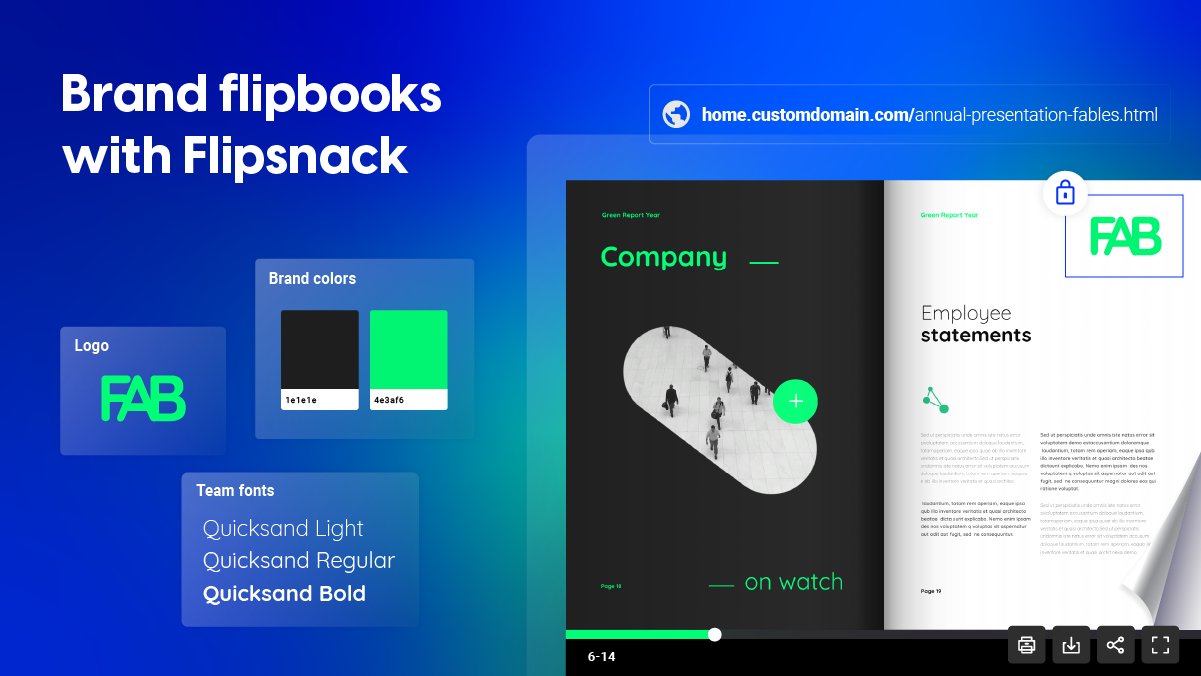
Flipsnack: Complete Buyer's Guide
Accessibility-first AI brochure creator
Flipsnack positions itself as the accessibility-first AI brochure creator, distinguishing its approach through automated compliance features and rapid deployment capabilities that consistently deliver marketing-ready content within days rather than weeks.
Market Position & Maturity
Market Standing
Flipsnack occupies a specialized niche in the AI brochure creation market, positioning itself as the accessibility-focused alternative to design-heavy competitors like Canva Enterprise and Adobe Express[118][132].
Company Maturity
Company maturity indicators suggest established operational scale with documented enterprise customers across real estate, education, and retail sectors[136].
Growth Trajectory
Growth trajectory evidence shows expansion in accessibility-focused features and multilingual capabilities, indicating strategic investment in compliance-driven market segments[118][132].
Industry Recognition
Industry recognition appears through customer case studies demonstrating measurable engagement improvements, with documented success across multiple verticals including technology, retail, and manufacturing[119][129][131].
Strategic Partnerships
Strategic partnerships include integration capabilities with Zapier and Google Drive, enabling workflow automation connections with existing marketing technology stacks[133].
Longevity Assessment
Longevity assessment indicates stable operation with consistent feature development and customer support capabilities. The platform's focus on accessibility compliance and rapid deployment creates defensible market positioning, particularly as regulatory requirements for digital accessibility continue expanding across industries and geographic regions.
Proof of Capabilities
Customer Evidence
Customer evidence demonstrates measurable business impact across multiple industries. Radioshuttle® achieved a 650% increase in engagement after converting static presentations to interactive Flipsnack brochures, directly attributing this improvement to embedded videos and clickable elements that accelerated deal closures[119][131]. Melissa & Doug documented a 30% rise in sales inquiries within six months of deployment, citing interactive catalogs with product galleries and embedded demos as key performance drivers[129][130].
Quantified Outcomes
Quantified outcomes extend beyond engagement metrics to operational efficiency gains. Travel industry users report improved brochure update efficiency due to real-time editing and reusable templates[127], while Melissa & Doug documented 35% lower distribution costs versus print catalogs[129].
Case Study Analysis
Case study analysis reveals consistent patterns among successful implementations. Marketing-led rollouts typically achieve template standardization within 72 hours for initial setup, with full rollout including training often completed within one week[128][134].
Market Validation
Market validation appears through customer satisfaction patterns, with available reviews consistently highlighting responsive customer support and ease of use as primary platform strengths[126][127].
Competitive Wins
Competitive wins emerge in scenarios prioritizing accessibility compliance and rapid deployment over extensive design customization. Organizations requiring WCAG 2.1 compliance benefit from automated alt-text generation and screen-reader compatibility features[118][120].
Reference Customers
Reference customers span multiple industries with documented success in real estate (dynamic pricing brochures), education (interactive course materials), and retail (catalogs with shoppable tags)[136].
AI Technology
Flipsnack's AI technology core focuses on accessibility automation and content intelligence rather than generative design capabilities. The platform's AI package delivers automated content summaries for screen-reader compatibility, generating both text descriptions and image alt-text to improve WCAG 2.1 compliance[118][120].
Architecture
Architecture & deployment centers on cloud-based processing with API-driven automation capabilities for enterprise users. Clean CSV/Google Sheets data feeds enable effective automation through Flipsnack's API connections[121][125].
Primary Competitors
Primary competitors include FlipHTML5 (content generation focus), Publitas (e-commerce integration), Visme (design customization), and Canva Enterprise (template governance)[132][133].
Competitive Advantages
Competitive advantages center on accessibility-first approach with automated WCAG compliance features that competitors typically require manual implementation[118][120]. Rapid deployment capabilities consistently under one week contrast favorably with Canva Enterprise's 2-6 week implementation periods[118][126].
Market Positioning
Market positioning occupies accessibility-focused niche distinct from design-heavy competitors, creating defensible positioning for compliance-driven organizations while potentially limiting appeal for creative-intensive applications.
Win/Loss Scenarios
Win/loss scenarios favor Flipsnack when organizations prioritize accessibility compliance, multilingual distribution, rapid deployment timelines, and marketing-led implementation over extensive design control.
Key Features

Pros & Cons
Use Cases
Integrations
Pricing
Featured In Articles
How We Researched This Guide
About This Guide: This comprehensive analysis is based on extensive competitive intelligence and real-world implementation data from leading AI vendors. StayModern updates this guide quarterly to reflect market developments and vendor performance changes.
136+ verified sources per analysis including official documentation, customer reviews, analyst reports, and industry publications.
- • Vendor documentation & whitepapers
- • Customer testimonials & case studies
- • Third-party analyst assessments
- • Industry benchmarking reports
Standardized assessment framework across 8 key dimensions for objective comparison.
- • Technology capabilities & architecture
- • Market position & customer evidence
- • Implementation experience & support
- • Pricing value & competitive position
Research is refreshed every 90 days to capture market changes and new vendor capabilities.
- • New product releases & features
- • Market positioning changes
- • Customer feedback integration
- • Competitive landscape shifts
Every claim is source-linked with direct citations to original materials for verification.
- • Clickable citation links
- • Original source attribution
- • Date stamps for currency
- • Quality score validation
Analysis follows systematic research protocols with consistent evaluation frameworks.
- • Standardized assessment criteria
- • Multi-source verification process
- • Consistent evaluation methodology
- • Quality assurance protocols
Buyer-focused analysis with transparent methodology and factual accuracy commitment.
- • Objective comparative analysis
- • Transparent research methodology
- • Factual accuracy commitment
- • Continuous quality improvement
Quality Commitment: If you find any inaccuracies in our analysis on this page, please contact us at research@staymodern.ai. We're committed to maintaining the highest standards of research integrity and will investigate and correct any issues promptly.